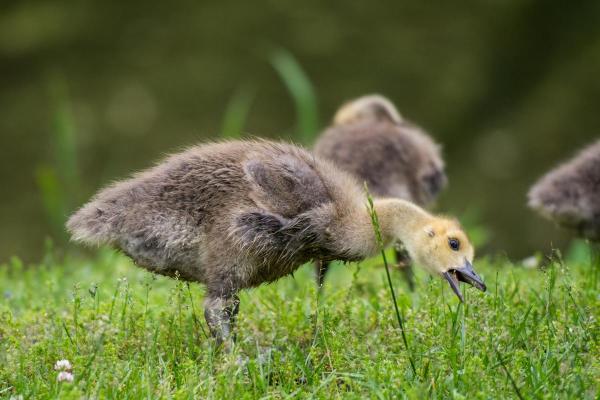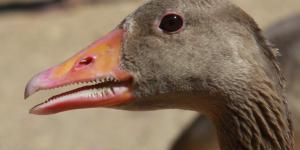How Long Does a Goose Live? - Geese Lifespan


Geese, members of the Anatidae family and closely related to ducks and swans, are large, flighted waterfowl known for their graceful silhouettes, distinctive honking calls, and often-gregarious behavior. Found worldwide in a variety of habitats, including wetlands, grasslands, and urban areas, geese have long been associated with human culture, serving as symbols of loyalty, perseverance, and adaptability. But, have you ever wondered how long do geese live?
The following AnimalWised article explores the lifespan of wild and domesticated geese, as well as the factors that influence their longevity in different environments.
What is a goose?
Geese, belonging to the Anatidae family alongside ducks and swans, are medium to large-sized waterfowl known for their distinctive honking calls and V-shaped flying formations during migration.
Their robust bodies, long necks, webbed feet, and broad, flat bills are adaptations for their herbivorous lifestyle and aquatic habitats. Geese primarily feed on grasses, grains, and aquatic vegetation, obtaining the nutrients they need for their energetic flights and maintenance. Their migratory patterns, spanning vast distances between breeding and wintering grounds, highlight their remarkable adaptations for long-distance travel.
Domesticated geese, derived from wild species, have been raised by humans for various purposes, including meat, eggs, feathers, and as ornamental birds. On the other hand, wild geese play essential ecological roles, dispersing seeds and influencing wetland ecosystems. Their presence and activities contribute to the overall health and diversity of these ecosystems.
Canada geese, Greylag geese, Snow geese, and Barnacle geese are popular goose species, each with unique characteristics and adaptations.
Interested in the habits of geese? Find out where they sleep during the night in our article.
Life cycle of a goose
The life cycle of a goose, much like that of many birds, encompasses distinct stages from birth to maturity. Below, we outline the key aspects of the typical goose life cycle:
Egg stage
The life cycle begins with the incubation of eggs, usually laid in well-constructed nests within secure and sheltered locations. After an incubation period lasting approximately 28 to 30 days, the eggs hatch, giving rise to the birth of young goslings.
Birth
The initial phase of parental guidance for goslings typically lasts for about 6-8 weeks. During this time, goslings are closely monitored by their parents, who provide them with warmth, nourishment, and protection. They also teach them essential survival skills such as foraging, recognizing predators, and communicating within their group.
Developmental phase
The developmental phase of a goose is relatively short, typically lasting for about 3-4 months. During this time, goslings undergo a remarkable transformation, shedding their downy feathers and growing their adult plumage. They also develop their wings and learn to fly, initially taking short hops and gradually increasing their flying distance and stamina. Alongside these physical changes, goslings also develop their independence in foraging for food.
Sexual maturity
Geese typically attain sexual maturity between 2 to 4 years of age, depending on the species. Once mature, they become capable of reproduction and establishing their own families. For further insights into their habits, refer to the post "Where the Geese Sleep."
Reproductive cycle
Adult geese embark on the reproductive cycle when they reach sexual maturity, typically around 2 years of age. They engage in courtship rituals to attract mates, and once a pair is formed, they work together to build a nest out of vegetation and downy feathers. The female goose then lays a clutch of eggs, typically between 2 and 12, which she will incubate for around 28-30 days. During this time, the male goose will stay close to the nest to protect it from predators and provide warmth to the eggs.
Adulthood and parental roles
As geese mature beyond their reproductive years, they continue to play a vital role within their social groups. They act as experienced mentors, passing on valuable knowledge and skills to younger geese. Their wisdom and guidance help maintain group cohesion and ensure the survival of the next generation.
Dive deeper into the anatomical wonders of geese and discover if they have teeth in our other article.

How long does a wild goose live?
The lifespan of wild geese varies among species and is influenced by environmental factors. Here's accurate information about the life expectancy of some goose species:
- Common Goose (Anser anser): typically lives between 10 and 20 years in the wild, affected by factors such as food availability, the presence of predators, and weather conditions.
- Canada Goose (Branta canadensis): known for long migrations, with a life expectancy ranging between 10 and 25 years. Successful migration and reproduction can impact longevity.
- Magellanic Goose (Chloephaga picta): native to South America, generally has a life expectancy of 10 to 15 years in the wild.
- Nile Goose (Alopochen aegyptiaca): native to Africa, usually has a life expectancy between 15 and 20 years in its natural habitat.
- Tundra Goose (Anser albifrons): also known as the black-eyed goose, has a life expectancy ranging between 5 and 15 years, influenced by conditions in breeding and migration habitats.
- Ashy Goose (Cereopsis novaehollandiae): native to Australia, typically has a lifespan of 15 to 25 years in the wild, possibly related to water and food availability.
- Japan Goose (Anser cygnoides): also known as the swan goose, usually lives between 10 and 20 years in the wild. Lifespan can be affected by factors like water quality and the presence of predators.
- Ross's Goose (Anser rossii): nesting in the Arctic, has a life expectancy varying between 10 and 15 years. The extreme conditions of the Arctic environment can influence their longevity.
These are general ranges, and individual and population circumstances can influence life expectancy. Additionally, threats such as hunting, habitat loss, and pollution may significantly impact the longevity of wild geese.
Expand your knowledge by exploring the fascinating variety of geese species in our informative piece.
How long does a domestic goose live?
The lifespan of domestic geese is contingent on factors like care, environment, and health. In ideal conditions with proper care, they generally live between 10 and 20 years, although instances of lifespans exceeding 30 years are not uncommon. Factors influencing longevity include diet quality, disease prevalence, living conditions, and veterinary care.
Geese raised for meat or plumage production often have shorter lifespans than those in welfare-oriented environments. Genetic selection and husbandry practices, such as breeding for specific traits, also play a significant role in determining the health and lifespan of domestic geese. Additionally, factors like exposure to pollutants, the availability of clean water, and protection from predators contribute to their overall well-being and longevity.
Now that you've explored the life cycle of a goose, delve into the fascinating differences between geese, swans, and ducks in our next article.

If you want to read similar articles to How Long Does a Goose Live? - Geese Lifespan, we recommend you visit our Facts about the animal kingdom category.
- Abraham, K.F., Jefferies, RL, & Alisauskas, RT (2005). The dynamics of landscape change and snow geese in mid-continent North America. Global Change Biology , 11 (6), 841-855.
- Black, J. M. (2001). Fitness consequences of long-term pair bonds in barnacle geese: monogamy in the extreme. Behavioral Ecology , 12 (5), 640-645.
- Hemetsberger, J., Scheiber, IB, Weiß, B.M., Frigerio, D., & Kotrschal, K. (2010). Influence of socially involved hand-raising on life history and stress responses in greylag geese. Interaction studies , 11 (3), 380-395.
- Ogilvie, M. A. (2010). Wild geese . A&C Black.







